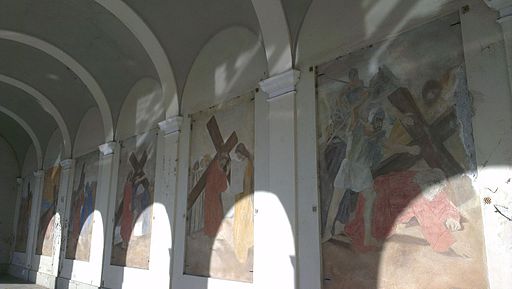For centuries Christians have retraced the steps of the Way of the Cross (Via Crucis), a path that leads to the hill of the crucifixion, with their gaze fixed on its ultimate goal, the resurrection of the Lord on Easter Sunday. They have made that journey as pilgrims along the Via Dolorosa (sorrowful way) in Jerusalem’s old city, but also in their own cities, churches and homes. Jerusalem has the great and tragic privilege of being the city of the historical Way of the Cross, the Sorrowful Way, the “Via Dolorosa”. The “Via Crucis” or Way of the Cross is defined by faith and not by history. It is a fusion of three different devotions that were widespread from the beginning of the XV century, especially in Germany and in the Netherlands:
-a devotion to the times that Christ fell under the weight of the cross
-a devotion to the «sorrowful way of Christ» that consisted at
first in processions from one church to another, (sometimes as many as
seven or nine different churches) commemorating the sorrowful way. These
processions marked Jesus’ different «processions» during the passion
narratives: from Gethsemane to the house of Annas (John 18:13); from the
house of Annas to the residence of Caiaphas (John 18:24; Matthew 26:56);
the walk to the Prætorium of Pilate (John 18:28; Matthew 27:2); the walk
to the Palace of Herod (Luke 23:7); etc.
-a devotion to the «stations of Christ» i.e. those moments in
which Jesus stopped along the way to Calvary, for reasons of the heavy
burden he was bearing, because of exhaustion, or moved by love and
compassion, in order to talk with those women and men along the way who
participated in his passion. Each of these stations was often marked with
a pillar or a cross which became objects of meditation and veneration.
The Way of the Cross devotion as we know it today with the fourteen stations is first attested to in Spain in the first half of the XVII century, especially in areas where Franciscans were present. It spread first to Sardinia (at that time under Spanish control), and then up the Italian peninsula. The Way of the Cross recalls the events of the suffering and death of Jesus Christ. The fourteen moments help the faithful to make a pilgrimage in spirit to the principal scenes of Christ’s suffering and death. It is carried out by passing from station to station, with certain prayers and scripture readings for each moment along Jesus’ sorrowful way to Calvary and his death on the Cross.
The 14 Stations on the Way of the Cross
1. Jesus is condemned to death
2. Jesus takes up his cross
3. Jesus falls for the first time
4. Jesus meets his Blessed Mother, Mary
5. Simon of Cyrene bears the cross
6. Veronica wipes Jesus’ face
7. Jesus falls again
8. Jesus meets the women of Jerusalem
9. Jesus falls a third time
10. Jesus is stripped of his garments
11. Jesus is crucified
12. Jesus dies on the cross
13. The body of Jesus is taken down from the cross
14. Jesus’ body is laid in the tomb
The stations emphasize the tragic interplay of persons, the struggle between light and darkness, between the truth and falsehood. The mere fact of carrying the cross is not what is most important. Many persons in this world suffer dramatically: every people, every family has on its shoulders sorrows and burdens to bear. That which gives fullness of meaning to the cross is to carry it behind Jesus, not in a journey of anguished solitude, hopeless wandering or rebellion, but rather in a journey sustained and nourished by the presence of the Lord.
The cross reveals the extent to which God will go for us out of love. Those who identify with the Via Dolorosa and the Cross of Jesus agree to identify also with the unwillingness to destroy and crucify. The question is not WHO killed Jesus, but WHAT killed Jesus… and what vicious cycles of violence continue to make the Lord walk the sorrowful way in women and men in our day, and what cycles and systems crucify him today in his sisters and brothers of the human family.
In Rome, the spiritual journey of the Way of the Cross in the footsteps of Jesus sets out anew each Good Friday, led by the Pope and Bishop of Rome in union with Christians the world over. Pope Francis will lead the Stations of the Cross on Good Friday evening in Rome’s Colosseum. The Colosseum has became closely associated with Christian martyrdom.
In concluding the Stations of the Cross at this very site on April 18, 2003, St. John Paul II said: “As we are every year, we are gathered here around the Colosseum. It is a symbol. This Colosseum is a symbol. Above all it speaks to us of times past, of that great Roman Empire that has collapsed. It speaks to us of those Christian martyrs who have given witness here with their life and their death. It is hard to find another place where the Mystery of the Cross speaks more eloquently than it speaks here, in front of this Colosseum.”

Historical Background of the Way of the Cross
A fusion of three different devotions that were widespread from the beginning of the XV century


